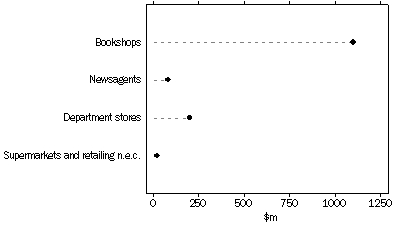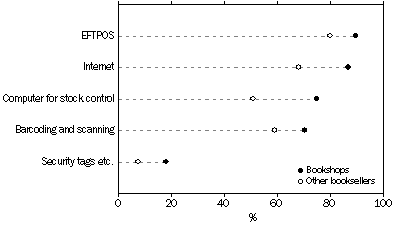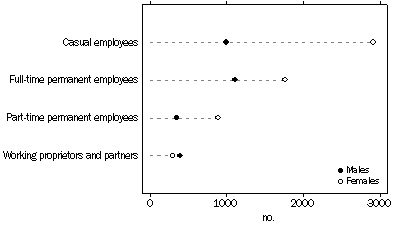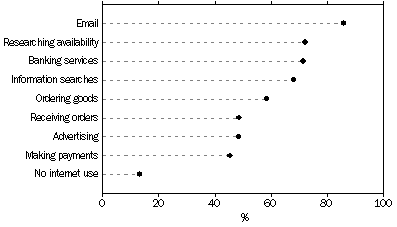NOTES
ABOUT THIS PUBLICATION
This publication presents the results from the 2003-04 Book Retailers Survey which collected information from businesses in four retail industries: Newspaper, book and stationery retailing, where all employing businesses were in scope; Department stores; Supermarket and grocery stores; and Retailing n.e.c., where only businesses employing 200 or more people were in scope. Sales of books by these businesses is estimated to cover the vast majority of book sales by employing businesses to final consumers in Australia, with the most recent estimate being 97% in 1998-99.
The publication provides details on the number and value of books purchased and sold, as well as information on the book related operations of the four industries named above. In addition, information is provided on the detailed operations of bookshops, including their employment, expenses and income.
The survey was conducted by the Australian Bureau of Statistics (ABS) with funding provided by the Department of Communications, Information Technology and the Arts as part of the Book Industry Assistance Plan.
ROUNDING
Where figures have been rounded, minor discrepancies may occur between the sums of the component items and the totals. Published percentages are calculated prior to rounding of the figures and therefore some discrepancy may occur between these percentages and those which could be calculated from the rounded figures.
INQUIRIES
For further information about these and related statistics, contact the National Information and Referral Service on 1300 135 070 or Tammie Smallacombe on Adelaide (08) 8237 7329.
SCOPE
This publication presents data in respect of the 2003-04 financial year from an Australian Bureau of Statistics survey of employing businesses involved in the retail sales of books. The survey is based on data collected from businesses classified to the following industries in the Australian and New Zealand Standard Industrial Classification (ANZSIC) (see paragraph 2 of the Explanatory Notes):
- Supermarket and grocery stores (ANZSIC 5110)
- Department stores (ANZSIC 5210)
- Newspaper, book and stationery retailing (ANZSIC 5243)
- Retailing n.e.c. (ANZSIC 5259).
Only the larger retailing businesses (those with 200 or more employees) classified as Supermarkets and grocery stores; Department stores; and Retailers n.e.c. have been included as the book retailing activity of smaller businesses in these industries is negligible.
Businesses classed as Newspaper, book and stationery retailing (ANZSIC 5243) have been further categorised as either ‘Bookshops’ or ‘Newsagents’ based on their level of bookselling activity. In this ANZSIC class, those businesses with new book sales comprising at least 50% of their total income have been categorised as ‘Bookshops’ while those with less than 50% have been categorised as ‘Newsagents’ (see paragraph 8 of the Explanatory Notes).
Many businesses operate from more than one location; however, only the activity of locations in Australia have been included in the collection. All book sales by overseas businesses selling directly to final consumers through the Internet or mail order have been excluded from the collection.
CONTENT
Chapter 2 of this publication summarises the book retailing activities of all book retailers indicated above. Apart from providing data on the number and value of books sold, the Chapter gives selected financial information on the book related operations of retailers. Information is also provided on the adoption of technology by these booksellers.
Many of the book retailers included in the survey sell a variety of other goods often making it difficult to separate the costs involved and levels of employment associated with just the sale of books. Consequently, detailed information is only presented on the business operations of retailers with a predominant activity of selling books (i.e. bookshops). Chapter 3 focuses on these bookshops which were responsible for the majority (78%) of the value of new book sales in 2003-04.
INTRODUCTION
Sales of almost 80 million new books valued at $1,406.5m were reported by the 1,572 employing businesses identified as having retail bookselling activity in 2003-04. The majority of businesses were newsagents (991 businesses), responsible for 6% (5.1 million) of the new books sold. Most new books (67% or 53.2 million) were sold by the 561 businesses classified as bookshops. The five major department stores sold a further 19% (15.4 million) of the new books while the remaining 8% (6.1 million) were sold by the seven major supermarkets and seven businesses classified as major retailers n.e.c. (tables 2.1 and 2.2).
Smaller department stores, supermarkets and retailing businesses n.e.c. (i.e. those employing less than 200 people) were previously found to have negligible book sales and were therefore excluded from the survey (see paragraph 4 of the Explanatory Notes).
Almost all new book sales (98%) were printed books, although $27.1m of electronic and audio books were also sold. As the survey only covers Australian businesses (i.e. businesses operating within Australia), it is not possible to determine the overall level of consumption of books as these items are sometimes purchased directly from overseas businesses (table 2.3).
A comparison of the values reported in 2003-04 with those reported in 2002-03 indicates that there has been little change in the activities of book retailers overall between the two periods. While the surveys indicate slight increases in the numbers of new books sold and in the income derived from book sales, neither increase was found to be statistically significant.
However, different trends are apparent when analysing bookshops and other booksellers separately. While bookshops reported significant increases for both the number of new books sold and the value of retail sales of new books, there was a significant decrease in the number of new books sold by other booksellers. The decrease in the value of sales of new books by other booksellers was too small to be significant. One factor which is related to this is the change in the average sale price of books; which decreased for bookshops, but increased for other booksellers over this period.
VALUE OF NEW BOOKS SOLD
In total, book retailers earned $1,406.5m in income from the sales of new books. More than three-quarters (78% or $1,103.3m) of this income was attributable to bookshops. In comparison, department stores were responsible for 14% ($200.2m) of the total income from the sales of new books; newsagents 6% ($80.9m); and businesses classified as supermarkets and retailing n.e.c. a total of 2% ($22.2m) (tables 2.1 and 2.2).
The average sale price of books varied across the different types of retailers. The price of a new book from a bookshop was $21 compared with $16 from a newsagent, $13 from a department store and $4 from the remaining booksellers (tables 2.1 and 2.2).
Final consumers also purchased books from other sources, including directly from book publishers. Estimates in the ABS publication, Book Publishers, Australia, 2003-04 (cat. no. 1363.0), show sales of books from book publishers to final consumers generated $305.9m in 2003-04.
Value of new book sales, By type of retailer

INCOME
While book retailers reported a total income of $61,134.4m, the majority of that amount ($59,727.9m or 98%) was not from the sale of new books. The importance of new book sales to the overall operations of businesses varied substantially for the different types of book retailers. Bookshops generated 85% of their income from the sale of new books. In contrast, newsagents relied on new book sales for 7% of their income while for department stores and combined supermarkets and retailing businesses n.e.c., new book sales were 1% or less of the total income (tables 2.1 and 2.2).
On average, individual bookshops reported income of $2.0m from the sale of new books and another $0.3m from other sales and services. In comparison, each newsagent earned on average $0.1m from book sales and $1.1m from other activities. While the five larger department stores reported an average value of new book sales of $40.0m, this was relatively small when compared to their overall average income of $2,955.5m. The larger supermarkets reported an average value of new book sales of $1.2m and the larger retailing businesses n.e.c. an average of $1.9m - both also relatively small figures compared to their overall incomes of $6,052.1m and $216.8m respectively (tables 2.1 and 2.2).
In 2000-01, the Educational Textbook Subsidy Scheme was introduced to assist students at Australian educational institutions. Under the Scheme, book retailers gave discounts to students for textbooks on prescribed lists and then claimed back the value of the discount from the Australian Government. In 2003-04, book retailers claimed $9.6m in return for discounts provided to students. Bookshops claimed $9.3m of this amount, compared with $0.4m by other booksellers (table 2.3).
EXPENSES
For most book retailers, it is not possible to separate expenditure on bookselling from expenditure on the sales of other products. This is particularly true for department stores and supermarkets which sell a wide range of products and for which new book sales are generally only a very small part of their total sales. Therefore, of the total expenditure of book retailers as a whole ($59,035.6m), the sale of books is a very small component.
One distinguishable book related expense for book retailers is the purchase of books. In 2003-04, book retailers spent $940.6m or 2% of their total expenditure on purchasing new books. In contrast, for bookshops, purchases of books was 53% of their total expenditure. On average, bookshops spent $1.2m each, or a total of $678.4m, on the purchase of new books, while the other book retailers spent an average of $0.3m each or a total of $262.1m (tables 2.1 and 2.2).
Bookshops purchased a total of 46.4 million new books at an average price of $15. By comparison, other book retailers purchased 35.2 million books at an average price of $7. Book retailers purchased most (89% or $600.9m) of their new books from Australian suppliers (table 2.4).
USE OF TECHNOLOGY
In 2003-04, 96% of book retailers used computers and a range of selected other technologies, including EFTPOS (Electronic funds transfer at point of sale), barcode scanning systems and electronic security systems, in the operation of their business. Almost all (98%) of the bookshops reported using at least one of the technologies, as did the majority (96%) of the other booksellers (table 2.5).
Over 83% of the book retailers had EFTPOS devices allowing consumers to purchase books using their credit or debit cards. Barcoding and scanning systems, used to record revenue and also for stock control, were used by 63% of businesses while electronic article surveillance or security tag systems were used by 11% of businesses (table 2.5).
Use of technology, By type of retailer

INTRODUCTION
This Chapter provides detailed information on the operation of bookshops including their income, expenditure, profitability and employment.
OVERVIEW
In 2003-04, there were 561 employing businesses classified as bookshops because they reported that their new book sales were at least 50% of their total income. These businesses operated from 896 retail locations around Australia (table 3.8). The larger businesses (those with 20 or more people in employment), while representing only 7% (38 businesses) of the total number of bookshops, had 57% ($627.5m) of the total income from new book sales and sold 50% (26.7 million) of the books. They also incurred 62% ($795.9m) of the expenses (table 3.2).
For 2003-04, bookshops recorded an operating profit before tax of $16.6m and a profit margin of 1.3%, which was not statistically significant from the previous year, when the profit margin was 1.9%. Despite their higher proportion of total income, larger businesses did not generate a higher profit margin than the smaller businesses (those with 0-19 persons employed). The profit margin for smaller businesses was 2.5%, while the larger businesses reported a profit margin of 0.5% (table 3.2).
Bookshops recorded changes for most data items between 2002-03 and 2003-04, although not all were statistically significant (see paragraph 27 of the Explanatory Notes). Two changes that were significant were the increase in the number of new books sold (from 42.8m in 2003-03 to 53.5m in 2003-04) and associated with that, the increase in the value of retail sales of new books (up by 17% over the same period, from $941.7m to $1,103.3m). Total income and expenditure also increased significantly, by 22% and 23% respectively.
INCOME
Bookshops reported a total income of $1,297.0m of which 85% ($1.103.3m) was from retail sales of new books. New book sales were supplemented by retail sales of other goods (including second-hand books) ($131.1m); the sale of services ($23.5m); the Educational Textbook Subsidy Scheme ($9.3m); and other sources such as wholesale sales and income from royalties ($29.6m) (table 3.3).
EXPENSES
The total expenses for bookshops were $1,287.6m in 2003-04. The purchase of goods for resale represented 59% ($757.2m) of total expenses, which included $678.4m for the purchase of new books. Wages and salaries were 14% ($180.3m) of total expenses. A further 2% ($29.3m) was spent on other labour costs. There was a range of items covering the remaining 25% of costs, including: $90.8m for rent, leasing and hiring; $34.3m for advertising and $18.7m for depreciation and amortisation (tables 3.2 and 3.4).
EMPLOYMENT
At the last pay period ending June 2004, bookshops had a total employment of 8,717 people. This comprised 697 working proprietors and partners and 8,020 employees. Of the employees, the highest proportion were casual (49% or 3,908 employees), followed by those employed as permanent full-time (36% or 2,876 employees) and those employed as part-time permanent employees (15% or 1,236 employees). Of the total employed, over two-thirds (5,862) were female, with half (2,913) of those being casually employed (table 3.7).
Persons employed, By sex

STATE AND TERRITORY DATA
Data were collected for the Australia-wide operations of each business. Businesses operating in more than one state or territory were asked to provide a state and territory breakdown for several key data items. Victoria reported the highest number of business head offices (235) and the largest number of retail locations (307). New South Wales reported the largest employment figures (3,526 people) (table 3.8).
USE OF TECHNOLOGY
Bookshops reported using the Internet for a variety of activities, with the most common use being emailing (86% of bookshops); for researching the availability or cost of goods and services (72%); for banking and financial services (71%); and for bibliographic or other information searches (68%). Over half (58%) of bookshops indicated that they had their own web site, home page or some other type of presence on the Internet (table 3.9).
Internet use for selected purposes

 Print Page
Print Page
 Print All
Print All